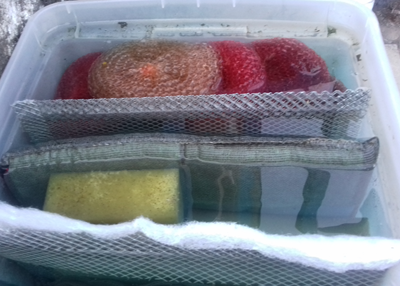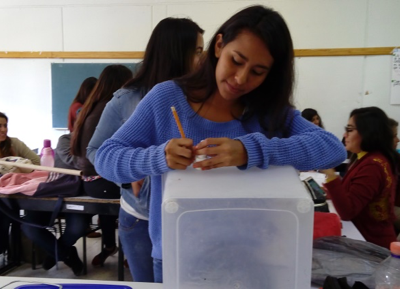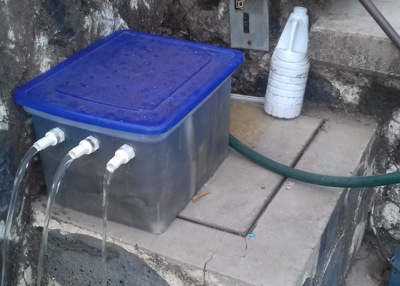Estudiantes (UPN)
La Universidad Pedagógica Nacional sede Cuernavaca, en los últimos años ha sufrido el problema de la escasez de agua, un problema que ya afecta a prácticamente toda la capital del estado de Morelos; esta situación se ha agudizado todavía más, porque el número de estudiantes ha aumentado como resultado de la apertura de nuevos programas educativos que ofrece la Universidad. En este contexto, las estudiantes del quinto semestre de la Licenciatura en Intervención Educativa (LIE), como parte de la materia Desarrollo Sustentable, conjuntamente con el profesor Jorge Domínguez, decidimos iniciar un “reto sustentable” con el objetivo de fomentar entre la comunidad universitaria el ahorro del agua.

La Universidad cuenta desde hace muchos años, con un sistema de fuentes, que aunque muy atractivas, consumían mucha agua debido a que cuando ésta se ensuciaba o adquiría el color verdoso del agua no tratada, debía ser sustituida por agua potable nueva. Para reducir el consumo del vital líquido, y después de un diagnóstico participativo, decidimos que la mejor manera de ahorrar agua y mantener atractivo el entorno de la Universidad, un estanque sería la mejor manera de combinar las necesidades con las oportunidades.
Gracias a la buena disposición del Director de la Universidad, el Maestro Aroldo Aguirre, pudimos disponer del espacio y las facilidades para nuestro estanque. Sin embargo, no teníamos la experiencia técnica para hacer un estanque con peces y plantas, entonces recurrimos a la ex-alumna, también de LIE, Antonia Sánchez, quien ya había realizado un estanque en una escuela secundaria como parte de un proyecto de intervención, apoyado técnicamente por la profesora Valeria Davila (Upemos) y financiado por el Proyecto Planteles Educativos Sustentables, por supuesto tuvimos que hacer un trabajo adicional de investigación.
Lo primero que debimos hacer fueron equipos que se encargaran de las distintas tareas, (investigación, diseño, materiales, adquisición de peces, etc). Una de las primeras cosas que hicimos fue el filtro, si queríamos mantener a los peces sanos debíamos garantizar su bienestar. Ya venden filtros para este propósito en tiendas especializadas, pero con lo que cuestan, no podíamos darnos ese lujo, por lo que debimos hacer un filtro nosotras mismas, de manera más artesanal, pero igualmente efectivo. Gracias al profesor Jorge que nos donó su caja plástica del archivo de su oficina tuvimos el material inicial, seguramente no le hacía mucha falta porque su oficina es un desorden de cualquier manera; el resto de materiales también eran de uso diario en la casa (cepillos de limpieza, esponjas y fibras de lavado, tela de perlón y piedra volcánica que hay en la propia Universidad).

Otro equipo se encargó de buscar quién nos podría donar un par de peces que se convertirían en los primeros moradores de nuestro estanque, ahora tenemos un par de carpas Koi, las plantas que colocamos son las que ya se habían reproducido del estanque de Antonia. Finalmente después de algunos intentos y errores tenemos nuestro estanque funcionando, los peces parecen perfectamente adaptados y sobretodo, estamos ahorrando agua, el profesor Jorge lleva una bitácora en la que se registra el agua que se consume, lo que nos permitirá evaluar el cumplimiento de nuestro objetivo.
Nuestro propósito inicial lo hemos cumplido, ahora esperamos que nuestros compañeros y profesores nos apoyen, haciendo suyo el deseo de comprometernos no sólo con el cuidado del agua en la Universidad, sino con lo que implica un compromiso con el desarrollo sustentable. Desde luego, las críticas no han estado ausentes, pero son las menos, la mayor parte de las personas nos han hecho sentir bien con sus palabras de aliento y apoyo, por ejemplo, las señoras encargadas de la limpieza nos han apoyado de manera extraordinaria, gracias por su colaboración y material que nos han facilitado, pero sobre todo por su entusiasmo. Gracias también al proyecto de Escuelas Sustentables quienes nos facilitaron el financiamiento para este proyecto.

The UPN Ayala’s Sustainable Challenge
UPN Students
The Cuernavaca campus of the Universidad Pedagógica Nacional has suffered a problem of water scarcity in the last few years, a problem that practically has affected the whole capital of the state of Morelos. This situation has worsened because of the increase in the number of students as a result of the opening of new educative programs offered by the university. In this context, the students of the fifth semester of the Educative Intervention Degree (LIE), as part of the Sustainable Development course, in conjunction with professor Jorge Domínguez, we decided to start a sustainable challenge with the objective of encouraging in the campus community the economy of water.

The University counts with a system of fountains that although attractive, consumed a lot of water since it has to be substituted with new potable water when it gets dirty or takes a green color because of the non treated water. To reduce the consumption of the vital liquid, and after a participant diagnosis, we decided that the best way to save water and maintain the surroundings of the university attractive, a pond would be the best way to combine necessities with opportunities.
Thanks to the good disposition of the University’s Director, Professor Aroldo Aguirre, we were given access to the space and support to work on our pond. However, we did not have the technical experience to make a pond with fish and plants so we recurred to a former student, also from the LIE, Antonia Sánchez, who made a pond for a High School as part of an intervention project, supported by Valeria Davila (from UPEMOR) and financed by the Sustainable Campuses Initiative. Of course, we had to do additional research.
The first thing that we had to do was to make teams that would take on different tasks (research, design, material, acquisition of fish, etc.). One of the first things we made was the filter, if we wanted to maintain the fish healthy, we needed to guarantee their well being. They now sell filters for that purpose in specialized stores bu because of their cost, we could not give ourselves the luxury of purchasing one, that is why we had to make the filter ourselves, in a more handcrafted way but just as effective. Thanks to professor Jorge, who donated us his plastic archive box from his office, we had the initial material. He probably did not need it because his office is a mess anyway; the rest of the materials also were of daily home use (cleaning brushes, sponges and cleaning fibers, perlon fabrics and volcanic stone that is found in the University itself).

Another team took the responsibility to find someone who could donate to us fish, who would become the first guests in our pond. We now have a pair of Koi Carps and the plants that we placed are the ones who had already reproduced in Antonia’s pond. Finally, after a few tries and mistakes, we have our functional pond. The fish look perfectly adapted and most importantly, we are saving water. Professor Jorge has a logbook where the water that is consumed is registered, which permits us to evaluate the accomplishment of our objective.
We have accomplished our initial purpose. Now we hope that the rest of the educational community and professors support us, making it their own wish, not only to care for the water of the university, but also to make a committment to what sustainable development implies.
The critics have certainly not been absent, but they are the least, the majority of the people have made us feel good with their supporting words. For example, the ladies in charge of the cleaning services have supported us in an extraordinary way. We thank them for their collaboration and the material that they made available to us but above everything for their enthusiasm. A big thank you to the Sustainable Campuses Initiative, who gave us access to the financing for this project.





